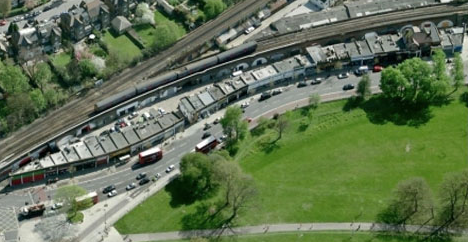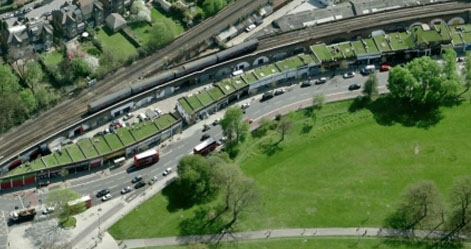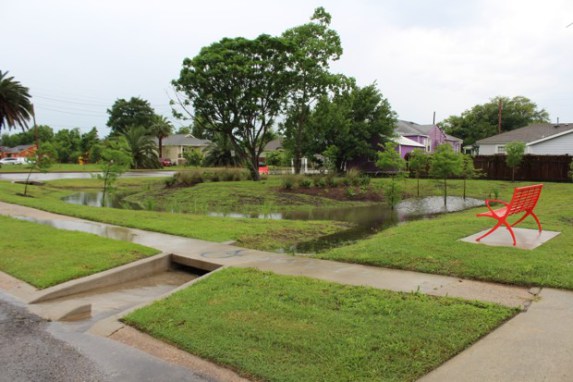Water Please! Rethinking Urban Blue Spaces after COP21
Too much of anything gets complicated fast, and this is especially true with water. With greater urbanization and the long-term effects of climate change, both European and U.S. cities are likely to feel the social, economic, and environmental effects caused by extreme weather events. COP21, also known as the 2015 Paris Climate Conference, brought together hundreds of global leaders in business, government, finance and NGOs with the aim of accelerating sustainable development. Participating negotiators discussed the impacts of the water crises, including droughts, floods, sea level rise, and pollution as posing the greatest threat to urban landscapes and populations. Changes to the water cycle are likely to impact not only the supply and demand of water but also the quality. Finally, and contrary to popular thinking, the consequences of not incorporating an integrated water management approach are likely to be felt in all cities and not only in coastal areas.
The term blue infrastructure describes the means in which rainwater and snowmelt is diverted from sewer/storm water systems into green systems like ponds, fields, and other natural settings. For many cities these systems are outdated and ineffective. Using strategic spatial planning tools to combine water management systems and green infrastructure together is crucial. New approaches and innovative designs, such as Water Sensitive Urban Design, will aid in creating multi-functional green spaces resilient to climate change and extreme weather.
Water Sensitive Urban Design (WSUD) is therefore an approach to the planning and design of urban environments that supports healthy ecosystems while creating attractive and resilient places through smart water management. Investing in such initiatives will benefit cities by:
(1) minimizing the impacts of water;
(2) reducing costs in infrastructure and development; and
(3) reinvigorating the public realm by providing quality spaces to be enjoyed.
Where can WSUDs be implemented? Since WSUD works at different scales – from block to regional – the application can be flexible and can be incorporated within different types of developments. Here are three examples of forward-thinking planning and designs that incorporate bold “blue” ideas into existing green infrastructure projects.
Floodable Parks
Following catastrophic flooding caused by heavy rainfall in 2011 and 2014, the Danish government released a city-wide plan to cope with future extreme weather events and create ‘climate-resilient neighborhoods.’ The redesign of Enghaveparken, a large public park in the inner Vesterbro district of Copenhagen, sets a precedent for dealing with excess rainfall by designing rainwater into the core vision. The center feature is a sports field that can store excess water in the structure of a pond during heavy rainfall. The park’s boundaries will also be lined with dykes designed to filter water around the grounds as well as to 100 small community gardens. This design serves as a sustainable and innovative solution to excess water without stripping the park of its purpose as a space for recreation.

Enghaveparken Floodable Park - Credit: Cowi, Tredje Natur and Platant
More than just a Green Roof
The Herne Hill High Line project includes the installation of approximately thirty green roofs on non-residential roofs in Herne Hill, a district in south London. Close to the river route of London’s ‘lost’ River Effra, this neighborhood is particularly susceptible to surface water and sewer flooding. Spurred on by The Urban Wild Project, members of Herne Hill have taken it upon themselves to bring about positive environmental change to their community. Working alongside shop owners, community groups, volunteers, council members, artists, and research students, The Herne Hill High Line green roof project is an example of what can happen when good practices and design are stimulated through community outreach. This project will also make a real difference in combating the effects of flash flooding by reducing the rate of rainfall leaving roofs, thus reducing strains on the sewer systems and reducing surface flooding.


Before and After in Herne Hill - Credit: Urban Wild Project
Comprehensive Community Action
After decades of fighting the tide, New Orleans is changing course. The Green Infrastructure Demonstration Projects, part of the Greater New Orleans Urban Water Plan and awarded the National Planning Excellence Award from Environmental Planning by the APA, demonstrate how underutilized spaces can be developed to function for wet and dry weather. During heavy rainfall these integrated systems are designed to retain storm water and transform vacant lots into aesthetically pleasing green spaces. While this practice is not uncommon, what makes New Orleans a unique case is the level of civic engagement and the implementation of these projects in low-income neighborhoods. While the devastation that followed Katrina was enormous and still poses exceptional challenges, the subsequent community involvement is resulting in exceptional solutions grounded in equity and environmental sustainability.

New Orleans - Credit: Waggonner and Ball
Finally, in partnership with the 100RC Network, the ‘Rotterdam Exchange: Water Management & Multi-Benefit Solutions Handbook’ highlights lessons learned from a three-day exchange of Chief Resilience Officers from nine cities, including Bangkok (Thailand), Berkeley (USA), Mexico City (Mexico), New Orleans (USA), Norfolk (USA), Rome (Italy), Rotterdam (Netherlands), Surat (India), and Vejle (Denmark). By opening the way for intercity cooperation, the exchange confirms the potential for cities to adopt innovative approaches to water management. With Heads of States heading to the United Nations in New York for a high-level signing ceremony of the Paris Agreement on April 22, 2016, this is an important time to discuss what needs to happen for this historic climate agreement to be fully put in motion. It is critical to look at integrating water cycle management with the built environment through planning and urban design as a proactive step to long-term climate change adaptation.
Featured Image Credit: Robert Lawton